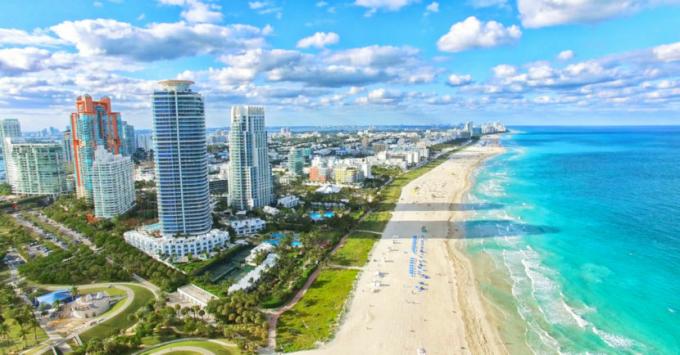The United States represents the greatest military, political, economic and cultural power today. US imperialism is one of the few empires that have achieved a global scale of efficiency and domination, a condition only conquered by the British (1815-1914) and by the Romans during the heyday of Ancient Rome (29 yr. Ç. up to 180 d. Ç.). Its highly diversified economy guarantees the country the position of the world's largest economy, with a GDP of approximately US$13 trillion. Due to the size of the US territory, it is possible to regionalize the country taking into account its natural and human aspects, individualized into five major regions.
1. Northeast region
Natural Aspects: Predominance of temperate climate, influenced by the Cold Labrador Current, which reduces the amount of rain due to less evaporation on the Atlantic coast. In the vicinity of the Appalachian Mountains, highly eroded plateaus, there are large reserves of iron and coal, which were fundamental to the US participation in the Revolution process. Industrial. In the Great Lakes region, bordering Canada, there is enormous hydraulic and navigational potential.
Human Aspects: Member of the Eixo Economico do Atlântico, the region was the most affected by the global economic crisis that began in 2008. The Northeast has the highest urban-industrial concentration, with emphasis on the traditional economic sectors, known as Manufacturing Belt (steel, metallurgy, automotive, naval, textile, among others). The region is the financial center of the United States, where the headquarters of the country's largest banks and financial institutions are located, such as the financial district of Wall Street, in New York. The largest population agglomerations are in the Northeast, with the presence of two megacities: BOS-WASH (Boston to Washington) and CHI-PITTS (Chicago to Pittsburgh). In the agricultural sector, the Dairy Belt, (milk and dairy production), Green Belt (vegetables), Corn Belt (corn) and Soybean expansion (soy bean).
2. South and Southeast regions
In common, they have the slavery past, recent economic modernization and the presence of warmer climates, with a tendency to tropicalization.
Southeast region
Natural Aspects: Predominance of subtropical climate.
Human Aspects: Use of climatic aspects for agriculture (some tropical products): orange, rice, tobacco, sugarcane and cotton (Cotton Belt).
South region
Natural Aspects: Subtropical (southern extreme), semi-arid and arid climates, including the formation of desert areas.
Human Aspects: The economy is centered on the petrochemical industry (the state of Texas has the largest reserves of US oil), war and aerospace, with intense growth in sectors related to Computing. In agriculture, the practice of dry farmings, large irrigation projects for the production of Cotton Belt and of wheat(Wheat Belt). Due to the large extensions of natural fields, known as steppes, extensive cattle raising (Ranching Belt) is also widely practiced.
3. Midwest Region
Natural Aspects: Temperate climate and relief formed by plains and undergrowth, set known as Praires (prairie) or Great Plains. Its rivers are widely used for navigation, such as the Mississippi-Missouri basin.
Do not stop now... There's more after the advertising ;)
Human Aspects: Strong relationship with agriculture, very modern and mechanized (Wheat Belt, Corn Belt, Soy Bean), covering the entire production chain of the sector (inputs, techniques, machinery, storage, transport) and with the support of the American government in the form of subsidies and protectionism.
4. West Region
Natural AspectsAttractions: Temperate, semi-arid and arid climates, with great influence from the Rocky Mountains. The vegetation is low (prairie and steppes). Due to the plateau and mountainous relief, rivers have hydraulic potential, such as the Columbia River and the Colorado River, the latter being the main agent that helped to shape the grandcanyon.
Human Aspects: Large demographic gaps occur due to mountainous formation and drier climates. The economy of this region is related to the extraction of ores (uranium, gold, copper, lead, zinc and oil), tourism and the Ranching Belt, favored by natural pastures.
5. Pacific coast:
Natural Aspects:In the south, in California, there is a predominance of dry climates, such as the semiarid and the Mediterranean (influence of the California Cold Current). Towards the North, occurrence of temperate oceanic climate.
The relief is characterized by the mountains of Cadeia da Costa, close to the coast, and two other mountainous groups: the Sierra Nevada, to the south, and the Cascata range, further north.
Human Aspects:Region characterized by the greatest economic and population growth in recent decades (Economic Hub of the Pacific), except for the state of Oregon, based on extractivism.
In the state of California there is a large concentration of cutting-edge industries and research centers, known worldwide as the Siliconvalley (Silicon Valley) in San Francisco. California is the state that has shown the greatest population growth and has the megalopolis SAN-SAN (San Francisco to San Diego). In agriculture, there is the practice of dry farming (irrigated fruit growing and Cotton Belt). California still has the 4th largest oil production in the country.
Washington state also has many cutting-edge industries in sectors such as computing, aerospace and warfare. The capital Seattle is home to an outstanding financial and banking sector.
The area formed by California and some southern and southeastern states is known as Sun Belt, having in common the predominance of warmer climates and the highest rates of economic and population growth in the country.
6. Alaska and Hawaii
The states of Alaska and Hawaii are not regionalized in any of these previous regions. Alaska has the largest oil production in the US, while Hawaii has an agricultural and tourism-oriented economy.
Julio César Lázaro da Silva
Brazil School Collaborator
Graduated in Geography from Universidade Estadual Paulista - UNESP
Master in Human Geography from Universidade Estadual Paulista - UNESP


